Sunday Post: Behind the Scenes at Stourhead House
For this week's Sunday Post, I uncovered an interview from our deep archive that I never properly wrote about, and turned it into a lovely long-read about the behind-the-scenes workings at Stourhead House in Wiltshire, one of my favorite places to visit in England.
Member Update
Our campaign to 300 members is going strong, and we've added quite a few new members this week. We're not up to 233 members, so we're making our way there! We also wanted to remind everyone of a couple of things:
- June 7th is the one-year anniversary of the Friends of Anglotopia Club, so many who signed up last year, will be charged for their yearly membership. The software we use to manage memberships should have notified you already. We hope you're able to stick around for another year.
- Club members now have access to exclusive discounts on subscriptions for Britain, Discover Britain, and Scotland Magazines. You can access the special links on the membership discount page here.
- If you're new to the club, don't forget to stop by Anglotopia.chat and join the discussion in our private member's only forum!
Sunday Post: Behind the Scenes at Stourhead

Editor's Note: An intimate tour of England's most famous landscape garden reveals stories of loss, restoration, and resilience. Back in 2016, we took a private guided tour of Stourhead House that was arranged thanks to the help of the Royal Oak Foundation. It was an incredible day as we were taken behind the scenes of the house. And while I did share a photo essay showing the behind-the-scenes of the house, I never really wrote an article about it. A few days ago, I was going through my archives and I found the recording of the tour that I took (I always record these things!), and went down memory lane and decided to finally write up an article about that special day. I'm sorry it took so long!
The spring afternoon light filters through the tall windows of Stourhead House, casting gentle shadows across the ornate plasterwork of the Picture Gallery. Sarah, our National Trust tour guide, stands beneath one of the magnificent Chippendale chandeliers, her voice carrying the weight of centuries as she begins to tell the story that has captivated visitors for generations.
"This has got information in it," she says, patting a worn folder she carries everywhere. "I'll take you around the sort of normal way." But there's nothing normal about what follows—a behind-the-scenes journey through one of England's most celebrated estates, where every room whispers secrets of triumph and tragedy.
Outside, the famous gardens bloom with spring flowers, the rhododendrons beginning to show their colors around the lake. In fact, many would argue that the gardens are more famous - and more visited - than the house itself. Which, I think is a shame, because the house is a treasure and is just as worth visiting as the gardens (made famous by the 2005 Pride and Prejudice film adaptation). So, today we're exploring the lesser-known interior, the private world of a family whose banking fortune built one of England's greatest houses, and whose final act of generosity ensured its survival.
The Foundation of a Dynasty
Stourhead's story begins in the bustling streets of London, where Sir Richard Hoare, the son of a horse dealer, founded what would become Britain's oldest private bank in 1672 (it is still in existence!). From humble beginnings in Cheapside, the business prospered rapidly. Sir Richard's acumen was such that Queen Anne knighted him, establishing the Hoare family among England's financial elite.
But it was Sir Richard's second son, Henry Hoare I, known affectionately as 'Good Henry', who would transform the family's commercial success into architectural immortality. In 1717, with banking profits flowing steadily, Henry made a decision that would change the English landscape forever: he bought Stourton Manor in Wiltshire.
"Henry bought it," Sarah explains as we stand in the entrance hall, surrounded by portraits of successive generations. The original manor house, she tells us, was "a rambling, draughty medieval" structure that had housed the Stourton family for over 500 years. But Henry had grander visions.
He commissioned the celebrated Scottish architect Colen Campbell to replace the existing building with something revolutionary—one of England's first Palladian-style villas. Named after the Italian architect Andrea Palladio, this architectural style emphasized symmetry, classical proportions, and the harmonious integration of building and landscape. It became all the rage during this period with great house owners and builders (and is probably the style most of us think of when we think of an English stately home).
The house was built by master builder Nathaniel Ireson between 1721 and 1725, establishing Ireson's career in the process. Tragically, Henry I died just before his architectural masterpiece was completed, never seeing the fruition of his grand design. His widow Jane continued to live on the estate until her death in 1741, when their son Henry Hoare II inherited the property.
Henry the Magnificent and the Garden of Memory
It was Henry Hoare II, known as 'Henry the Magnificent', who would transform Stourhead from a beautiful house into a complete work of art. Sarah points to his portrait as we enter the Music Room. "That's a picture of Henry II when he was just enjoying himself, having a great time going round Europe and buying up a lot of art."
The Grand Tours that wealthy young Englishmen undertook in the 18th century were formative experiences, and Henry's travels through Italy profoundly influenced his vision for Stourhead. Inspired by the paintings of Claude Lorrain, Nicolas Poussin, and Gaspard Dughet, he conceived a landscape garden that would bring classical mythology to life in the Wiltshire countryside.
Working with architect Henry Flitcroft, Henry II created what contemporary visitors described as "a living work of art." The famous lake, formed by damming a small stream, became the centerpiece of a carefully orchestrated journey through classical landscapes. Temples dedicated to Flora, Apollo, and Hercules punctuated views designed to evoke specific paintings and mythological narratives.
"This is their inspiration, the Grand Tour," Sarah notes as we examine landscape paintings in the Picture Gallery. She points to a view of Tivoli: "So that's about 20 miles outside Rome. I've been to Rome three times and I haven't got there yet. It will happen."
Henry II's passion for art extended beyond landscape design. His collection included works by Poussin, Rysbrack, and Bampfylde, many acquired during his European travels. The house itself underwent significant modifications under his direction, including the rebuilding of the West Front to accommodate the grand Saloon.
The Scholar and the Library
In 1785, Sir Richard Colt Hoare, grandson of Henry the Magnificent, inherited Stourhead on the unusual condition that he leave the family banking business and dedicate himself entirely to the estate. This proved fortuitous, as Colt Hoare possessed both the scholarly temperament and financial means to enhance Stourhead's already considerable splendor.
Colt Hoare's additions to the house included two wings—one for a Picture Gallery and another for a magnificent Library. Sarah shows us into this latter room, where approximately 6,474 volumes line the walls in specially designed Chippendale furniture. "It's also a question of what you consider a book," she notes with characteristic humor, "because they've got pamphlets and things as well."
The Library represents more than just a collection of books; it's a testament to the intellectual curiosity of the era. Colt Hoare was a pioneering archaeologist who, "with the antiquarian passion of the times, had 400 ancient burial mounds dug up to inform his pioneering History of Ancient Wiltshire." His scholarly works helped establish the modern archaeological method in Britain.
The room's centerpiece is an extraordinary Axminster carpet from the 1790s, designed specifically for the space. "You know that this is only the third carpet in... It's certainly 200 years, isn't it?" Sarah explains. "This was done in the 1790s. And it's based on a design, presumably that Richard Colt Hall saw in a Roman villa. So it's sort of based on... almost like a mosaic."
Colt Hoare also commissioned Thomas Chippendale the Younger to create furniture specifically for the Library, ensuring perfect integration between architecture, decoration, and function. The results, still in place today, represent some of the finest examples of Regency furniture design.
Decline and Crisis
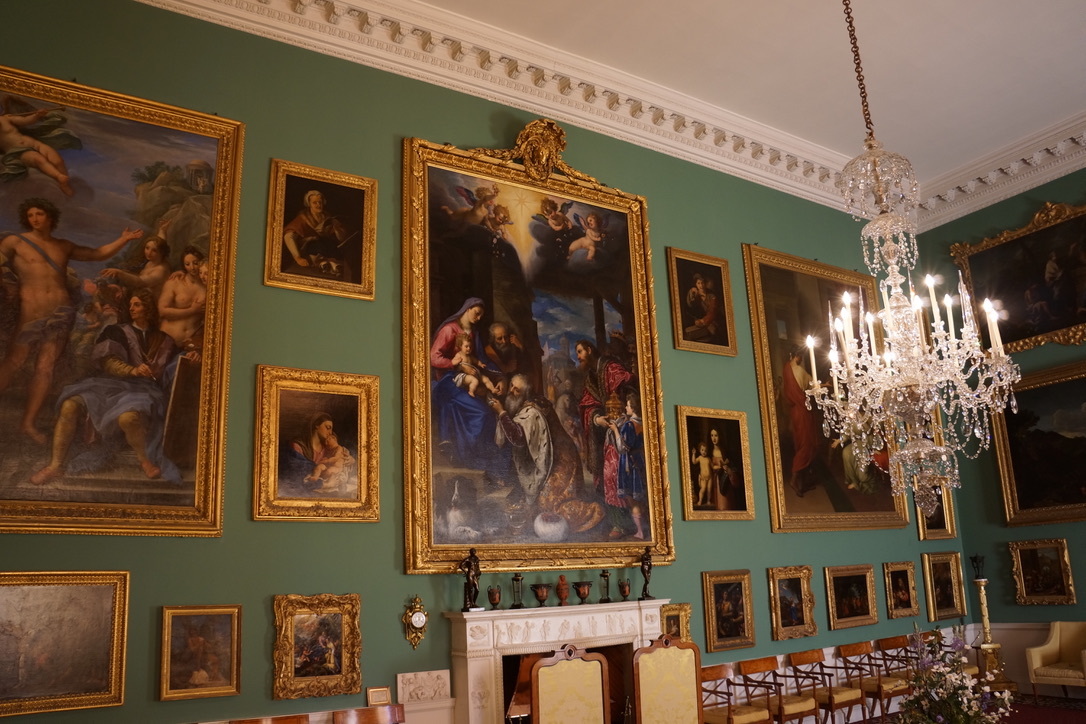
The 19th century brought challenges to the Hoare family fortune. When Colt Hoare died in 1838, the estate passed to his half-brother, Sir Henry Hugh Hoare, 3rd Baronet. During his brief tenure, Hugh Hoare added the portico to the front of the house, completing Colen Campbell's original design. However, the family was increasingly struggling with debts and the effects of an agricultural depression.
The crisis came to a head in 1883 under Henry Ainslie Hoare's ownership. Sarah explains the dire situation as we stand in the Picture Gallery, notably less crowded with art than in the house's heyday: "Henry Ainslie who was in charge in the 1880s which was when there was not much money coming in from agriculture there was a great slump and he still had a mortgage to pay off on the wings and he was a gambler."
The consequence was devastating for the collection. "So he sold off some of the best pictures and books, which was a shame. So the old Titian and Rembrandt, 10 Canalettos." The loss of these masterpieces—including works by Titian and Rembrandt—remains one of the most regrettable episodes in Stourhead's history.
Henry Ainslie, Sarah notes, "didn't enjoy living here. He was a townie, really, rather than a country fellow.” His urban preferences and gambling habits made him unsuited to the responsibilities of estate management. Fortunately for Stourhead, his son had predeceased him, and upon his death, the estate passed to his cousin—a man who would prove Stourhead's salvation.
The Fire That Nearly Destroyed Everything
Sir Henry Hugh Arthur Hoare, 6th Baronet, inherited Stourhead from his cousin in 1894. The house had lain empty for several years, its condition deteriorating under neglect. With his wife Alda, Henry embarked on an ambitious restoration, moving into the house in February 1895.
Their efforts to revive Stourhead were dramatically interrupted on a spring morning in 1902. As Sarah explains when we reach the little dining room, "In 1902, there was a fire. The whole of the central block burnt down to the ground."
The fire started as a chimney fire in one of the upper bedrooms—the very room where we later explored during our behind-the-scenes tour. "It wasn't just a fire. It was a chimney fire," Sarah notes. "The roaring noise you get up that chimney, it's really frightening. So, you know, the maid would have come in here to turn down the beds or whatever in the morning. I heard this awful noise. What's going on?"
What followed was a scene of controlled chaos that would determine Stourhead's fate. Old photographs in the Picture Gallery show the extent of the devastation—the central block was completely gutted, reduced to a smoking shell. Yet remarkably, most of the house's contents survived.
"All the servants, of course, Henry and Alder were out. All the servants brought themselves together, got out everything, virtually everything that you see." The servants' quick thinking and bravery saved irreplaceable artworks, furniture, and books that make up much of today's collection.
The restoration that followed was remarkably swift and faithful to the original design. Completed by 1907, the rebuilt central block showed little deviation from Colin Campbell's original vision, though some improvements were made to heating and other practical systems. As Sarah observes, "They managed to find somebody who could do it. And it's very similar to what it was in 1720."
A Family at War
The restoration coincided with a golden period in the house's history. Henry and Alda Hoare had one child, Harry, born in 1888, and they devoted themselves to creating a warm family home within the grand setting. Their correspondence with literary figures like Thomas Hardy, revealed in the Library, shows them as cultured, engaged members of society.
Harry grew up at Stourhead, learning estate management from his father and developing a deep love for the property. By all accounts, he was the perfect heir—responsible, well-liked by staff and tenants, and committed to carrying on the family traditions.
The outbreak of World War I changed everything. Harry joined the Dorset Yeomanry on August 1, 1914, and within a week was transformed from estate manager to soldier. During the war years, Stourhead opened its doors to wounded soldiers from the nearby Red Cross Hospital at Mere. Lady Alda organized regular outings for the "Tommies," allowing them to fish in the lake and providing tea at the Temple of Flora.
Lady Alda's diary entries from this period, preserved in the Wiltshire archives, reveal her deep empathy for the soldiers and her anxiety about her son's safety. Harry's military career was marked by repeated injuries and illnesses that brought him home to recuperate at Stourhead before returning to the front.
"They had one child, young Harry," Sarah's voice grows quiet as we examine family photographs in Audrey's sitting room. “Unfortunately, he was shot in Palestine and they took him to Alexandria to try and patch him up, but certainly he died of his wounds there."
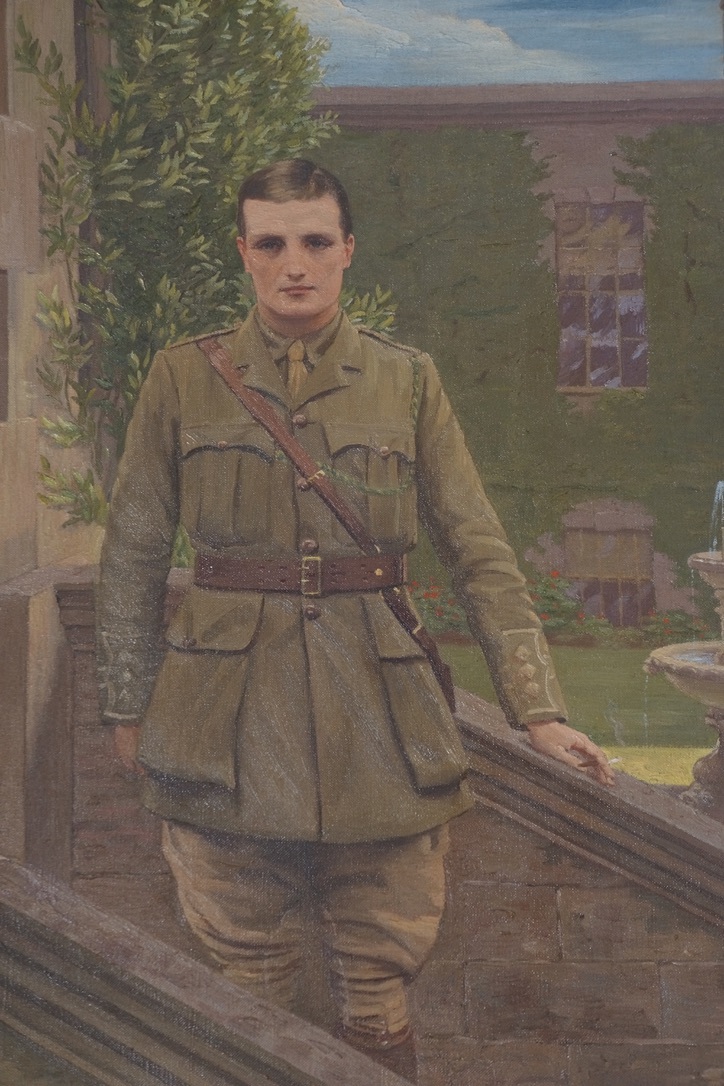
The details of Harry's death, recorded in his father's annals, are heartbreaking in their stark simplicity: "During the attack on Mughair Ridge shot through the lungs, at two a clock on Nov 17th 1917 died from haemorrhage & heart failure Capt Henry Colt Arthur Hoare at Raseltin Hospital Alexandria; and rests in the Hadra Military Cemetery there. Our only & the best of sons. He never grieved us by thought word or deed."
Even Thomas Hardy, the great novelist who had become a friend of the family, was moved to write a letter of condolence that captured the universal tragedy of the war: "If there were no other brand upon this odious & accursed War than that single loss, it must be most infamous & execrable to all posterity."
Artistic Treasures and Hidden Wonders
Despite the losses from Henry Ainslie's forced sales, Stourhead retains an extraordinary collection of art and artifacts. The Picture Gallery houses works that span centuries, from Renaissance masters to 18th-century British artists. Sarah points out subtle details that casual visitors might miss: how the painted glass windows create a pioneering form of pointillism, the way certain portraits include family pets, the ingenious use of mirrors to create dimensional effects with flat paintings.
"This room is incredible," Sarah says as we enter the Picture Gallery. The painted lunettes depicting scenes from Raphael's Vatican stanzas represent a remarkable achievement in decorative art. Each scene was carefully selected and adapted, creating what Sarah describes as "almost like a sort of an in-joke" for educated 18th-century visitors who would immediately recognize the classical references.
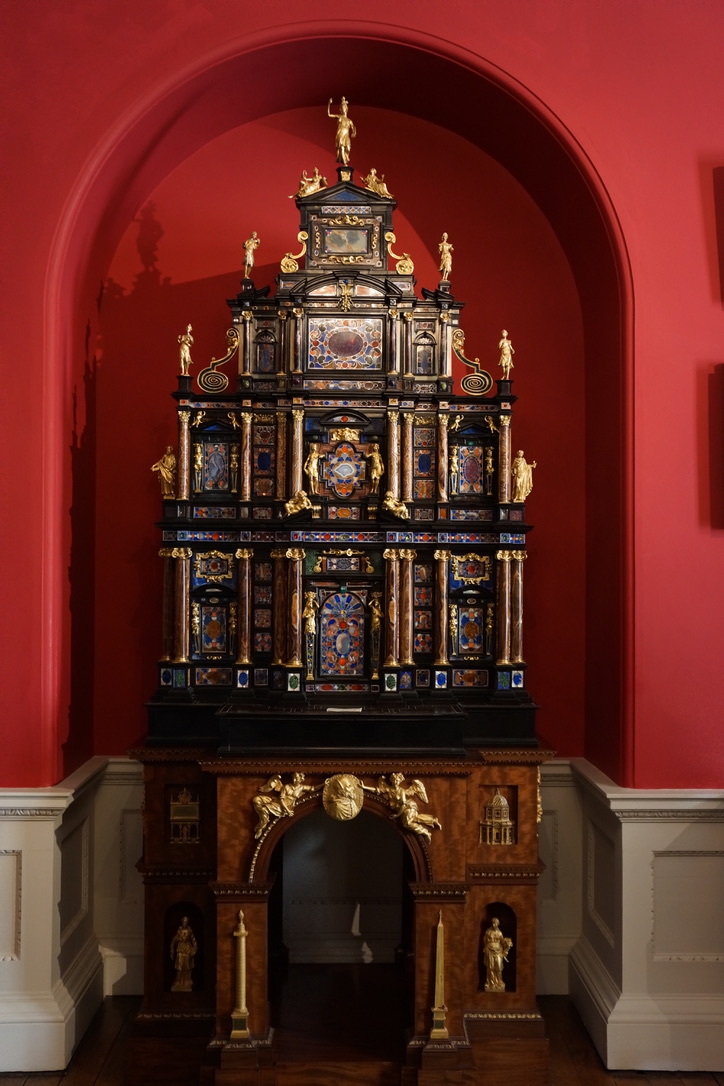
The Cabinet Room houses perhaps the most extraordinary single object in the house: a 16th-century cabinet that once belonged to Pope Sixtus V. Its creation required an entire Roman workshop, as Sarah explains: "The whole studio full of chaps working away and finding the right bits of stone that they could cut into thin slivers and then sort of like a jigsaw cut the right shape."
The cabinet contains "150 odd hidden cupboards and drawers," each crafted with microscoptic precision and finished with silver fittings. When Henry the Magnificent acquired it during the 18th century, he had the Cabinet Room built specifically to display it, surrounding this Renaissance masterpiece with painted views of ancient Rome.
The Canalettos that remain—notably a watercolor sketch of Westminster Bridge from 1745—represent the surviving fragments of what was once a major collection. Sarah reveals an interesting historical puzzle about this particular work: "He didn't turn up in England until after this was supposed to be painted... So he never actually saw that. So it's all in the imagination."
Life Below Stairs (and Upstairs)
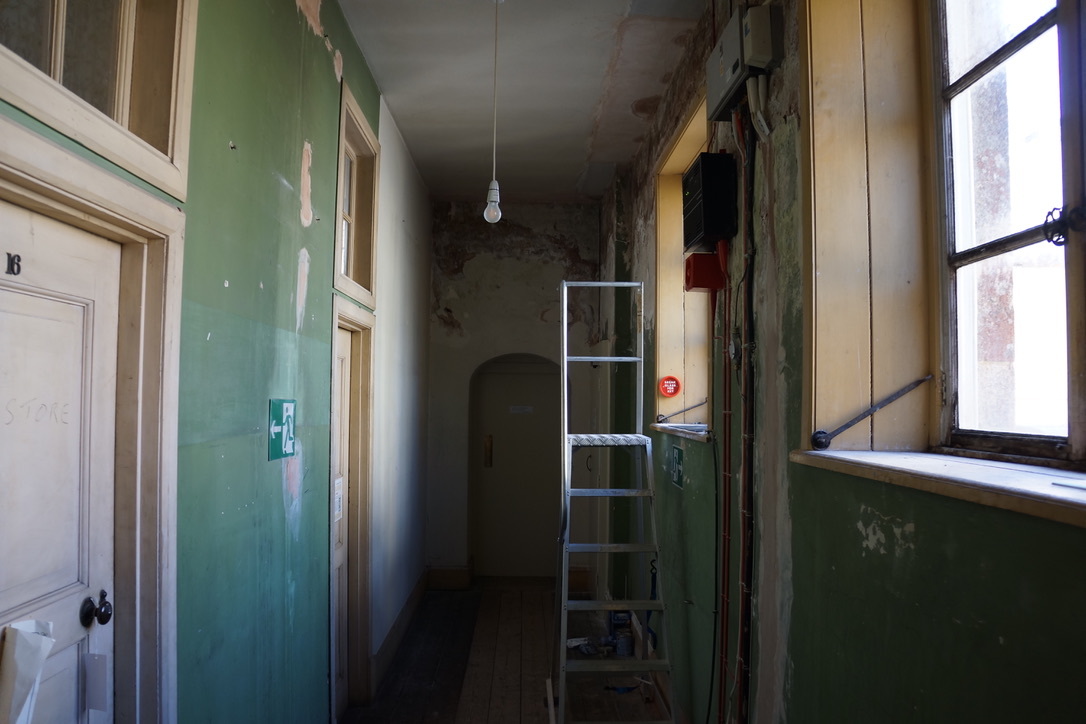
Our behind-the-scenes access extends to areas that few visitors ever see. The servants' quarters tell their own story of the vast human machinery required to maintain such an establishment. Sarah leads us up narrow staircases to rooms where maids and footmen once lived lives of strict routine and limited comfort.
"One of these is Van Dyke. Really? Exciting, I'm just trying to think. One's Rubens, one's Van Dyke," Sarah muses as we examine portraits in the servants' hall. Even in these utilitarian spaces, the family's love of art extended to providing decent surroundings for their staff.
The contrast between family and servant accommodations is stark. The servants' bedrooms are small, with windows positioned so that "the balustrade is in the way. And one of the thoughts is that's Alda saying, well, you know, what are the servants doing looking out the window? You're either working or you're asleep."
The sheer scale of domestic work required is illustrated by Sarah's coal statistics: "Over a ton of coal would be used on a cold winter's day. 135 times up and down all those stairs." The house employed a "tweenie"—a servant between scullery maid and housemaid—whose sole job was maintaining the fires throughout the house.
In winter, the servants' quarters would have been bitterly cold. Small coal grates provided minimal heat, and Sarah points out evidence of the harsh conditions: arsenic-containing wallpaper in some rooms, furniture arranged to provide maximum privacy in shared spaces, and the single bathroom that served the entire servants' wing.
The basement reveals the complex infrastructure of aristocratic life. Wine cellars still contain bottles dating back generations, some with handwritten labels and numbering systems that allowed the butler to locate specific vintages instantly. The dairy, built into the coolest part of the foundation, processed milk from the estate's cows. Most dramatically, man traps once used against poachers remain rusted in place—illegal now, but testimony to concerns about property security in earlier eras.
The Modern Stourhead
What makes Stourhead particularly fascinating today is how it continues as a lived-in space. When Sir Henry gave the house to the National Trust in 1946, the estate was divided. The Trust received the house, gardens, and approximately 2,300 acres, while the remaining 3,700 acres went to a distant cousin, Henry Peregrine Rennie Hoare.
"Yes, what they did," Sarah explains as we pass through Audrey's sitting room, "they divided the whole estate into two, there was about 6,000 acres and the trust got the house and the gardens... but the other half went to a cousin called Rennie Hall."
Rennie and his family initially lived in the house itself, but as Sarah notes, "I think it's a bit tricky trying to bring up children in a house which isn't yours but where you have got visitors coming around." They eventually moved to a farmhouse on the estate, but Rennie's daughter Audrey returned to live in a flat carved out of the main house.
Audrey's quarters provide a fascinating glimpse into modern life within historic walls. "Notice the sort of modern touches, the drinks tray, television. Girl after my own heart," Sarah observes with obvious fondness. The juxtaposition of contemporary furniture against 18th-century paneling creates an unexpectedly harmonious blend of past and present.
"I just love the thought of, you know, half past four, whatever time, you know, these doors are bolted shut and she can come in here and chuck all the cushions on the floor. Pour a drink. Turn on the telly. Yeah. Feet up." Sarah's delight in this domestic detail reveals how Stourhead successfully balances its role as a public monument and a private home.
The National Trust has adapted other parts of the house for practical purposes. Former servants' quarters now house conservation workshops, textile storage, and staff apartments. The old boot room has been converted into a flower-arranging room for WI volunteers who provide fresh flowers throughout the house.
Conservation Challenges
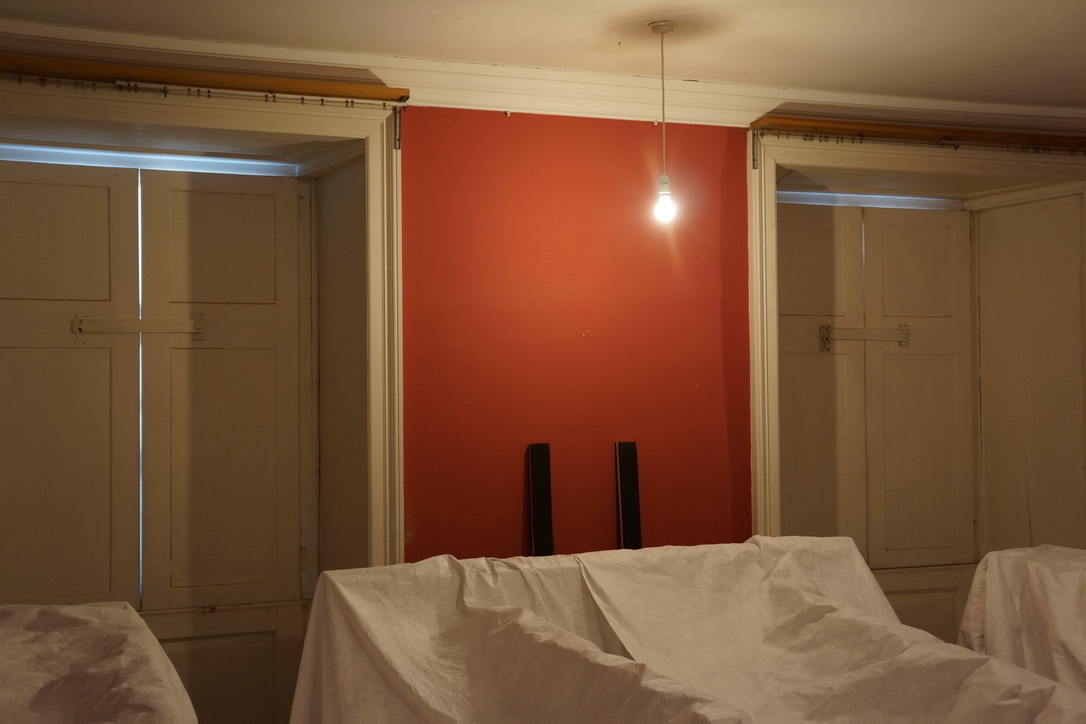
Maintaining a house like Stourhead presents constant challenges. Sarah explains how the Trust prioritizes conservation: "I suppose the heating is very much for the art, for the furniture, it's not for the people." Climate control systems protect delicate fabrics, paintings, and wood furnishings, but can make winter tours uncomfortable for visitors.
Light damage is a particular concern. In the textile collection room, "one dim light bulb, that's what you need, isn't it? To keep the low light is on purpose." The Trust has installed light monitoring devices throughout the house—small fabric samples that show how much damage even filtered daylight can cause over time.
Fire remains the greatest threat. Modern systems include heat sensors in chimneys, sprinkler systems in key areas, and regular fire brigade training sessions. Orange squares mark priority objects for evacuation, should the worst occur. "Those are the ones. Please get those out first," Sarah explains in the storage areas where surplus furniture awaits its turn for display.
The Trust employs a careful rotation system for textiles and paintings, ensuring that treasures not currently on display are properly stored and maintained. Furniture is regularly moved to prevent uneven wear, and specialist conservators regularly assess the condition of each piece.
Perhaps most challengingly, the Trust must balance preservation with access. Areas like the servants' quarters can only be opened for special tours because of limited staffing and safety concerns. "We just don't have enough volunteers to man it," Sarah explains, highlighting the constant tension between sharing Stourhead's treasures and protecting them.
Seasonal Rhythms
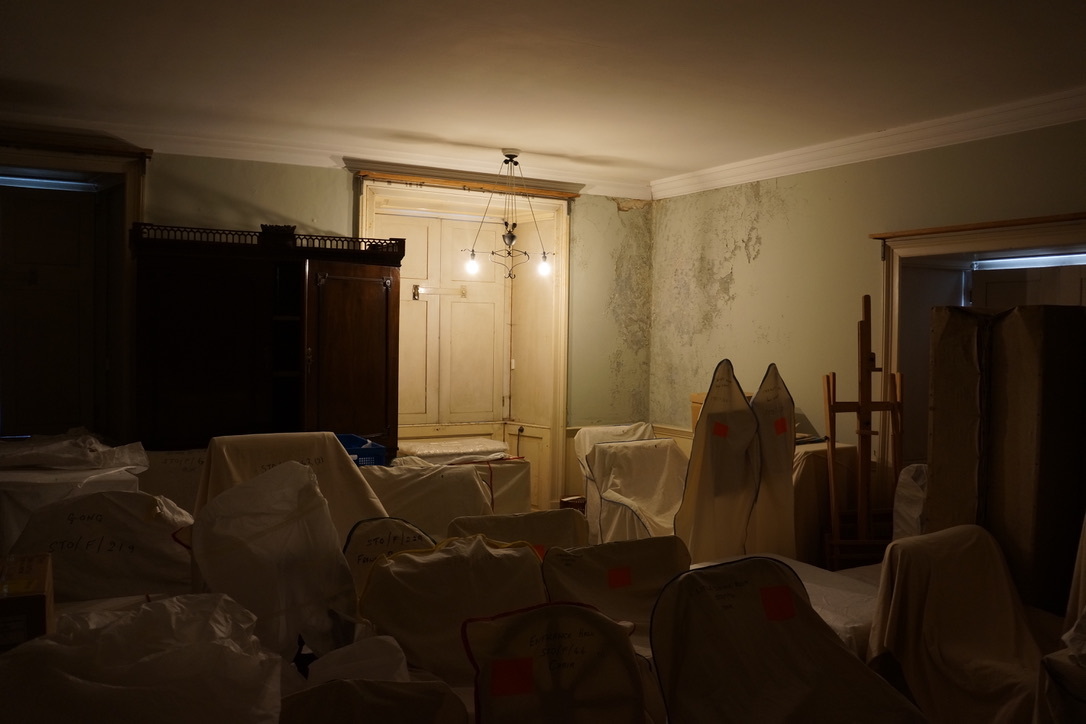
The house follows seasonal rhythms that echo its domestic past. Sarah mentions that "at Christmas time, we sort of close for about two weeks towards the end of November. And the house is decorated, about five or six rooms are decorated for Christmas."
During these special Christmas openings, volunteers in period dress recreate historical domestic scenes. "At the weekends, we have a chap who dresses up as the butler. Office people, a tot of, it's ginger wine." These events help visitors imagine how the house functioned during its heyday.
Spring brings its own activities. The famous rhododendrons, many planted by Richard Colt Hoare in the early 19th century, create spectacular displays around the lake. The walled garden comes alive with vegetables and flowers that echo the estate's agricultural heritage.
Summer sees Stourhead at its busiest, with the landscape garden drawing visitors from around the world. The house benefits from longer opening hours and better natural light that illuminates the paintings and decorative arts to their best advantage.
Winter tours offer a different perspective, when smaller groups can experience the house's more intimate atmosphere. Sarah particularly enjoys these quieter times: "in the winter, we sort of felt we needed it. We did" have fires in the main rooms, bringing warmth and the scent of woodsmoke that would have been constant in the house's occupied days.
The Future of Stourhead
As our tour concludes, standing in the Column Room where paintings show how the landscape has changed over centuries, Sarah reflects on Stourhead's continuing evolution. "That's so strange. Wouldn't it be great to have a photograph from exactly the same viewpoint? Because since that was painted, some of them would have been knocked down, some of them would have been lifted up."
The National Trust faces ongoing challenges in maintaining Stourhead for future generations. Rising visitor numbers strain the delicate balance between access and preservation. Financial pressures demand creative solutions for generating income while maintaining the property's integrity.
Yet Stourhead's survival through three centuries of change—from banking fortune to wartime tragedy to National Trust stewardship—suggests resilience built into its very foundations. The house that Henry I dreamed of, that Henry the Magnificent perfected, that survived fire and war and financial crisis, continues to fulfill its creator's vision as a work of art meant to inspire and delight.
The Trust's recent acquisitions, including the dramatic rescue of Angelica Kauffman's "Penelope and Euriclea" at auction, show ongoing commitment to reuniting Stourhead with its dispersed treasures. Conservation projects constantly reveal new details about the house's construction and decoration, while research in family archives continues to illuminate the lives of its former inhabitants.
A Living Monument
What emerges from spending time at Stourhead, particularly through a behind-the-scenes tour that reveals both its public grandeur and private functioning, is an understanding of the house as a living monument. This is not a museum frozen in time, but a place where past and present coexist in complex, sometimes contradictory ways.
The teenage Harry Hoare playing in the nursery that Sarah shows us in the attic represents the tragedy of broken continuity—the family line that ended on a Palestinian battlefield. Yet Audrey settling into her evening routine in her modern sitting room represents a different kind of continuity—life continuing within walls that have sheltered human stories for three centuries.
The servants who once climbed these stairs carrying coal scuttles have been replaced
by conservation specialists carrying environmental monitoring equipment. The family portraits still gaze down from the walls, but now they observe National Trust volunteers rather than blood relatives. The landscape garden still reflects the philosophical ideals of its 18th-century creators, but now welcomes half a million visitors annually rather than the select few who once received invitations to view it.
Henry Hoare's original vision—to create a place where art, nature, and human aspiration could combine into something greater than their individual parts—endures. The banking fortune that built Stourhead has long since passed to other hands, but the beauty it created continues to enrich lives in ways its creators could never have imagined.
As visitors walk through rooms where Chippendale furniture mingles with conservation equipment, where 18th-century paintings are lit by carefully controlled modern lighting, where Renaissance cabinets are protected by 21st-century security systems, they participate in a continuing story of care and preservation that spans generations.
Sarah's evident affection for Stourhead—her delight in sharing its stories, her humor about its quirks, her knowledge of its every corner—represents perhaps the most important element in its preservation. For ultimately, places like Stourhead survive not just because of National Trust policies or conservation science, but because individuals care enough to learn their stories and pass them on.
When the last visitor departs and the doors close for the day, when Audrey settles into her sitting room and the conservation systems hum quietly through the night, Stourhead continues its watch over the Wiltshire countryside. Tomorrow will bring new visitors, new stories, new moments of discovery. The house that began as one family's dream of perfection has become a shared heritage, a place where the past lives on not as nostalgia but as inspiration for the ongoing human project of creating beauty and meaning in the world.
We've put together a gallery of pictures I took while on the tour, which you can view here.
Stourhead House and Gardens are open to the public year-round. The National Trust offers specialized behind-the-scenes tours during certain periods, allowing visitors to explore areas normally closed to the public and gain deeper insights into the estate's operation and conservation. To book tours or check opening times, visit the National Trust website or contact Stourhead directly.
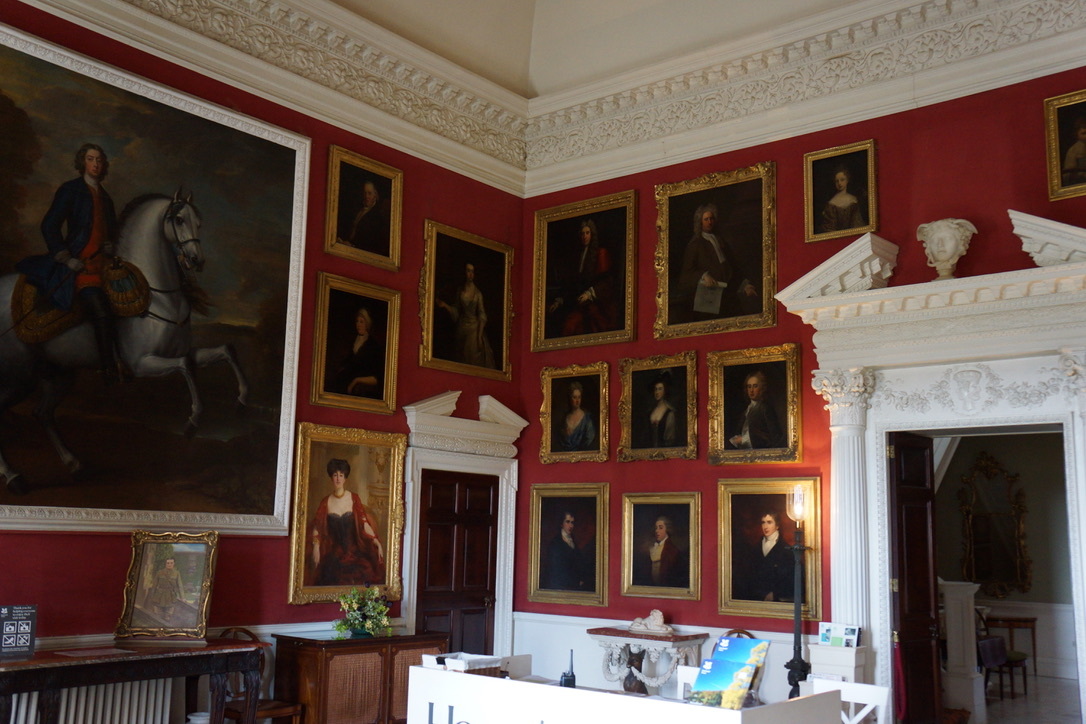
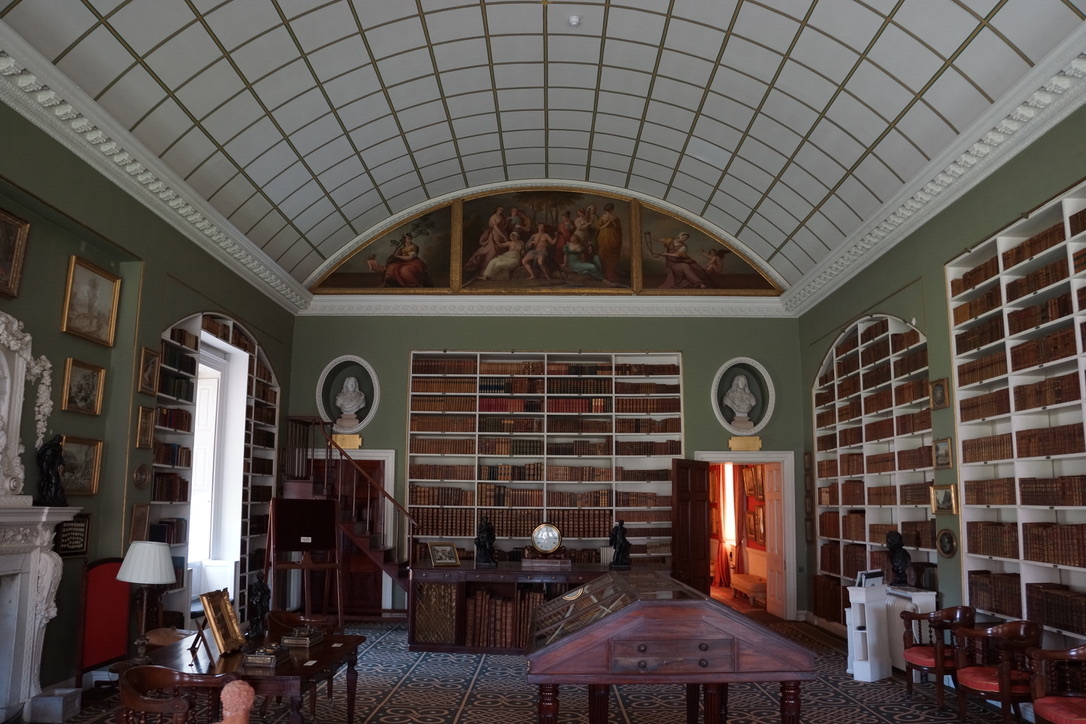

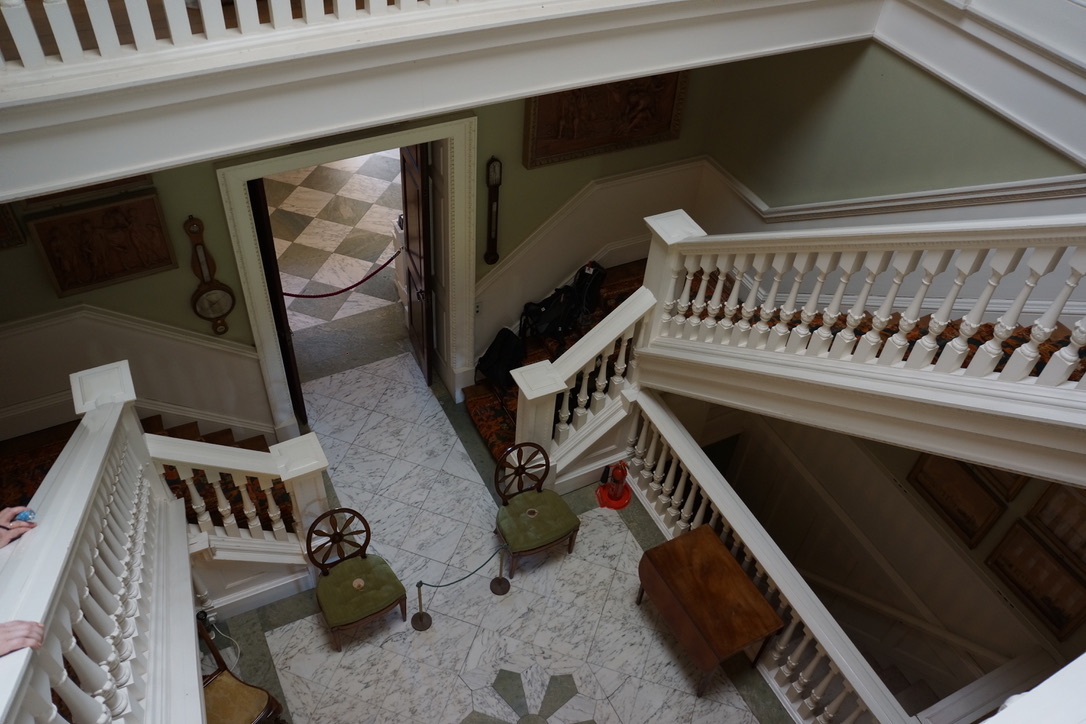
Post a reply